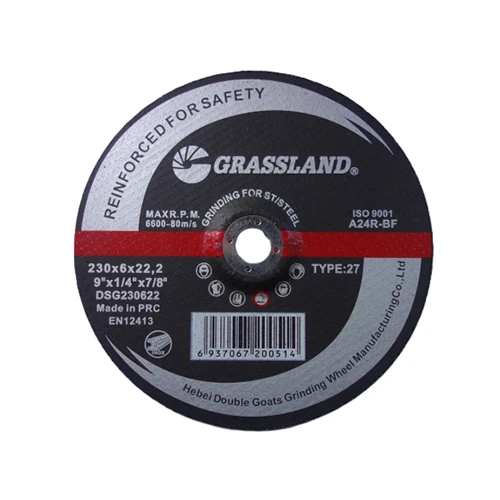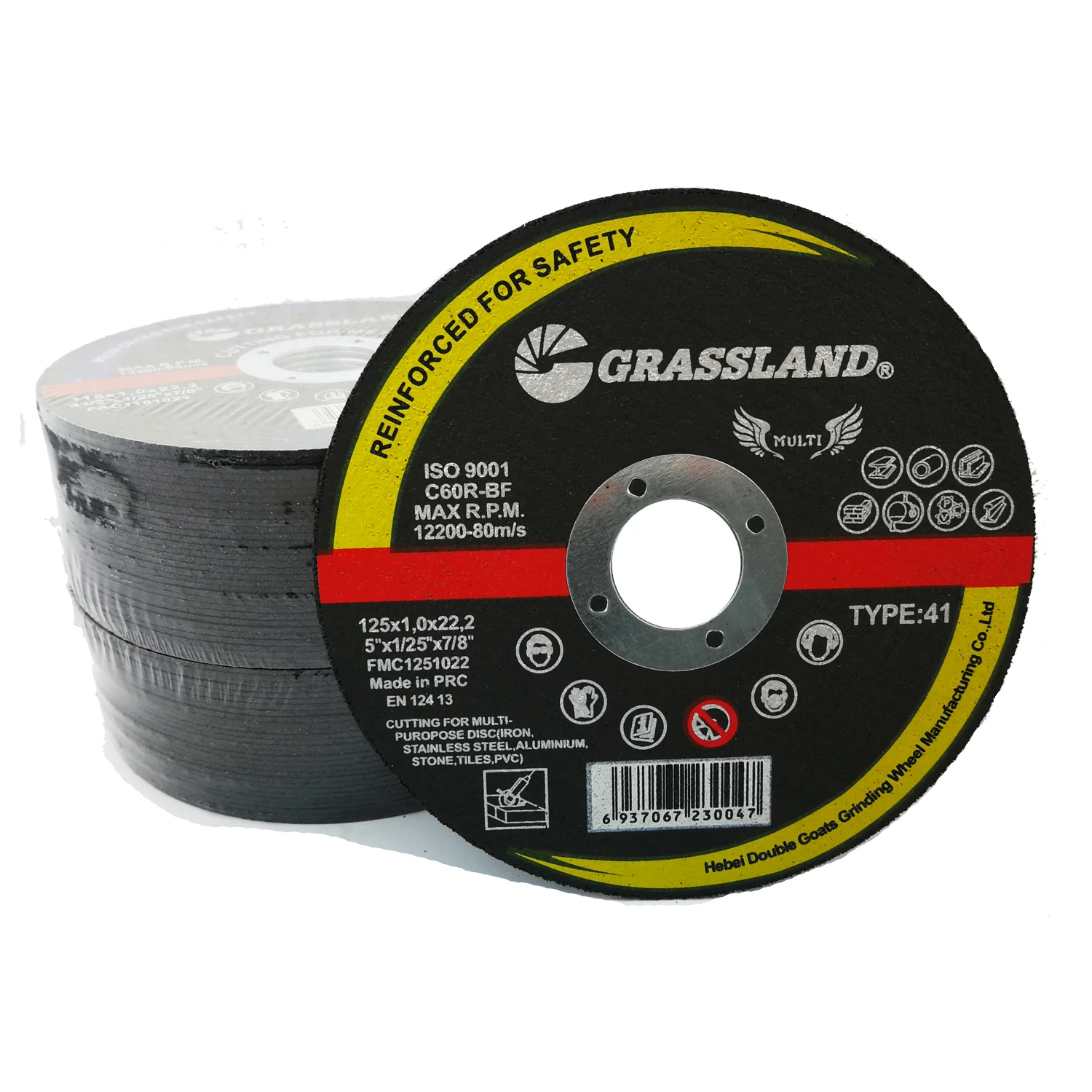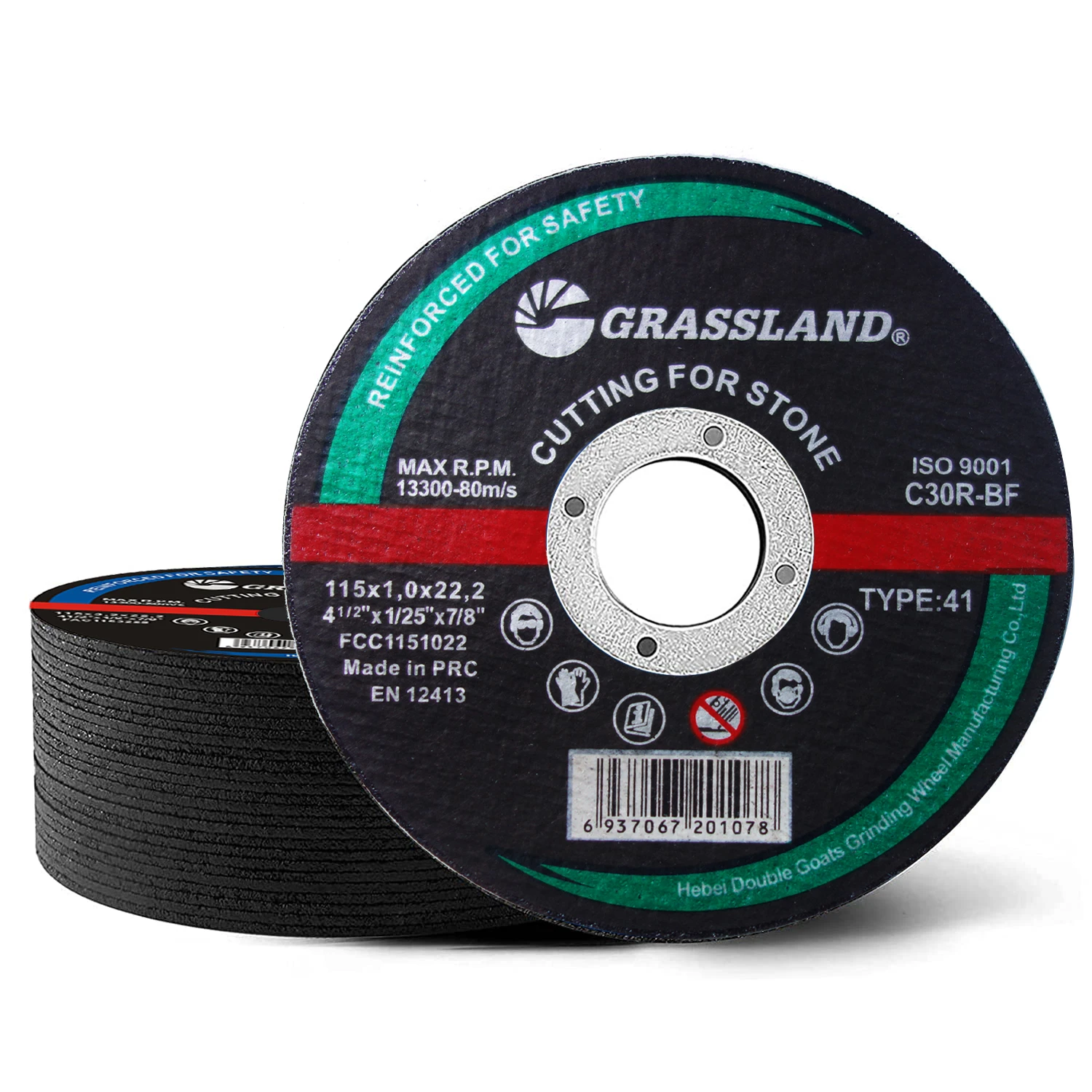Industry Trends in Abrasive Finishing
The industrial abrasives market is experiencing dynamic growth, driven by increasing demand from manufacturing, construction, and automotive sectors. Key trends include the pursuit of higher efficiency, enhanced safety standards, and sustainable manufacturing practices. Innovations in abrasive grain technology, such as advanced ceramic and zirconia alumina formulations, are leading to longer-lasting and more aggressive cutting tools. The adoption of specialized abrasives like the 40 grit flap disc is becoming crucial for optimizing material removal rates and improving surface preparation quality across various applications. Furthermore, the market is seeing a push towards products that offer both aggressive grinding capabilities and improved finish quality, minimizing the need for multiple grinding steps. This is particularly relevant for operations where both high stock removal and a foundation for subsequent finer finishing are required.
Within the metalworking sector, the evolution of high-strength alloys and composite materials necessitates abrasive solutions capable of maintaining performance under arduous conditions. This has fueled the demand for durable and efficient tools, with a particular emphasis on products that reduce operator fatigue and minimize project lead times. The emphasis on worker safety also drives innovation in products that reduce vibration and dust generation. As industries strive for leaner operations and reduced energy consumption, the selection of superior abrasive tools like a 40 grit flap disc becomes a strategic decision, directly impacting operational costs and overall productivity. The versatility of a flap wheel 40 grit, suitable for diverse applications from weld grinding to edge chamfering, underscores its growing importance in modern fabrication and maintenance.
Technical Specifications and Parameters
A 40 grit flap disc is engineered for aggressive material removal, offering a blend of rapid stock removal and a comparatively smoother finish than traditional grinding wheels of similar grit. Its design comprises multiple abrasive flaps layered radially around a central hub, providing a continuous fresh abrasive surface as the disc wears. This self-sharpening characteristic contributes significantly to its extended lifespan and consistent performance.
Key technical parameters are critical for optimizing performance and ensuring safety in industrial applications. For instance, a 4.5 flap disc 40 grit is commonly specified for angle grinders due to its ergonomic benefits and operational flexibility. The abrasive grain type is usually Zirconia Alumina (ZA) or Aluminum Oxide (AO), with ZA offering superior aggression and longevity for metal applications. The backing pad material, typically fiberglass or plastic, provides structural integrity and vibration dampening.
Typical Product Specifications: Angle Grinder Metal 4-1/2" 40 Grit Flap Disc Wheel
| Parameter | Specification |
|---|---|
| Disc Diameter | 4.5 inches (115 mm) |
| Grit Size | 40 Grit |
| Abrasive Grain | Zirconia Alumina (ZA) or Premium Aluminum Oxide |
| Backing Pad Material | Fiberglass, Type 27 (Depressed Center) |
| Bonding Agent | Phenolic Resin |
| Maximum RPM | 13,300 RPM (Typical for 4.5") |
| Application Suitability | Metal grinding, deburring, stock removal, weld blending |
| Target Materials | Stainless Steel, Carbon Steel, Alloy Steels, Cast Iron |
These specifications ensure that a 40 grit flap disc for metal provides optimal performance in demanding industrial environments, adhering to safety standards like ANSI B7.1 for abrasive products. Understanding these parameters is crucial for selecting the right abrasive for specific material and application requirements, maximizing efficiency, and minimizing operational costs.
Technical Advantages of 40 Grit Flap Discs
The technical advantages of employing a 40 grit flap disc are multifaceted, contributing significantly to enhanced productivity, cost reduction, and improved finish quality in various metalworking operations. Compared to traditional rigid grinding wheels, flap discs offer superior conformability, allowing them to adapt better to contoured surfaces and reduce gouging.
- High Material Removal Rate: The aggressive 40 grit abrasive grain, often Zirconia Alumina, ensures rapid stock removal on various metals, making it ideal for heavy grinding, weld removal, and deburring tasks. This efficiency translates directly into reduced labor time per piece.
- Extended Service Life: The design of a 40 grit flap wheel, with its layered abrasive flaps, means that new, sharp abrasive is continuously exposed as the disc wears. This self-sharpening action prolongs the disc's effective grinding life, outperforming traditional grinding wheels and reducing the frequency of disc changes.
- Improved Finish Quality: While aggressive, the flexible nature of flap discs minimizes heat buildup and reduces the likelihood of surface discoloration or warping. This often results in a smoother, more consistent finish than coarser grinding wheels, potentially reducing the need for subsequent finishing steps.
- Reduced Vibration and Noise: The inherent flexibility and design of flap discs contribute to reduced vibration during operation, enhancing operator comfort and safety. Lower noise levels also improve the overall working environment, aligning with modern industrial health and safety standards.
- Versatility: A single 40 grit flap disc can often perform tasks that would typically require a grinding wheel followed by a fiber disc, consolidating processes and streamlining workflows. This versatility makes it a highly cost-effective and efficient abrasive solution for shops handling a wide range of metal fabrication tasks.
- Enhanced Safety: Flap discs are generally considered safer than rigid grinding wheels due to their design, which mitigates the risk of shattering upon impact. Their lighter weight also reduces strain on operators.
These technical advantages make the 4.5 flap disc 40 grit an indispensable tool in modern metalworking, offering a balanced combination of aggressive grinding, durability, and a refined finish.
Application Scenarios
The versatility and robust performance of a 40 grit flap disc for metal make it a preferred abrasive choice across a multitude of heavy-duty industrial applications. Its aggressive stock removal capabilities are particularly valuable in sectors where speed and efficiency are paramount, while its ability to achieve a relatively smooth finish simultaneously reduces the need for secondary operations.
Target Industries and Typical Uses:
- Metal Fabrication and Welding: Indispensable for weld preparation, weld grinding, and weld blending on stainless steel, carbon steel, and various alloys. The 40 grit quickly removes excess weld material and smooths the joint, preparing the surface for subsequent finishing or coating.
- Automotive and Heavy Equipment Manufacturing: Utilized for deburring metal components, preparing surfaces for paint or adhesion, and repairing structural elements. Its efficiency in removing scale and rust also makes it valuable in maintenance and overhaul operations.
- Petrochemical and Energy Sector: Essential for pipeline construction and maintenance, including beveling pipe edges, grinding internal and external welds, and preparing surfaces for corrosion-resistant coatings. The robustness of a 40 grit flap wheel is critical in these demanding environments.
- Shipbuilding and Marine: Used for surface preparation on large metal structures, grinding down imperfections, and preparing surfaces for protective marine coatings. Its ability to handle aggressive stock removal on various steel types is highly valued.
- Foundries and Casting Operations: Excellent for removing risers, gates, and parting lines from metal castings. The 40 grit quickly grinds away excess material, making cast parts ready for further machining or finishing.
- General Maintenance, Repair, and Operations (MRO): Widely used for rust removal, paint stripping, and general surface conditioning on equipment, machinery, and infrastructure components.
In these scenarios, the 40 grit flap disc demonstrates clear advantages such as energy saving through faster material removal, excellent corrosion resistance surface preparation (by effectively cleaning metal surfaces), and prolonged service life even under heavy loads. For critical infrastructure like water supply & drainage systems, this translates to efficient preparation of metal pipes and fittings, ensuring reliable and long-lasting installations.
Manufacturing Process of a 40 Grit Flap Disc
The production of a high-performance 40 grit flap disc is a precision-driven process, integrating advanced material science with sophisticated manufacturing techniques to ensure consistent quality, durability, and optimal performance. Adherence to international standards like ISO 9001 and ANSI B7.1 is critical throughout the entire process.
Schematic Steps in Flap Disc Manufacturing:
- Abrasive Cloth Preparation:
- High-quality abrasive cloth, typically made with Zirconia Alumina (ZA) or Aluminum Oxide grains in 40 grit, is selected. This cloth features a robust backing (e.g., polyester or cotton) impregnated with abrasive grains bonded by a resin system.
- The large rolls of abrasive cloth undergo slitting into narrow strips of precise width, which will form the individual flaps.
- Flap Cutting and Forming:
- The slit abrasive strips are then cut into individual rectangular or trapezoidal flaps of specific dimensions. Advanced CNC machining or precise cutting dies ensure uniformity.
- Each flap may be pre-bent or formed to facilitate optimal overlap and presentation on the disc.
- Backing Pad Production:
- Fiberglass backing pads are molded or stamped to the required diameter (e.g., 4.5 inches for a 4.5 flap disc 40 grit) and shape (typically Type 27 depressed center). The fiberglass construction ensures strength, rigidity, and resistance to high rotational forces.
- For certain applications, plastic or aluminum backing pads may also be used, offering different levels of flexibility and weight.
- Flap Assembly and Bonding:
- This is the core assembly step. A precise number of abrasive flaps are arranged uniformly and concentrically around the center of the backing pad. The exact overlap and angle of the flaps are crucial for the disc's grinding performance, balance, and wear characteristics.
- A high-strength phenolic resin bonding agent is applied to secure the flaps firmly to the backing pad. This resin undergoes a curing process, often involving heat and pressure, to create an extremely durable bond that can withstand high RPMs and aggressive grinding forces.
- Curing and Hardening:
- After assembly, the entire disc is subjected to a controlled curing process in specialized ovens. This step fully polymerizes the resin bond, imparting maximum strength and heat resistance to the disc.
- Trimming and Balancing:
- Excess material is trimmed, and each disc is meticulously balanced to prevent vibration during operation, which is critical for operator comfort and consistent performance.
- Quality Control and Testing:
- Each batch of 40 grit flap disc undergoes rigorous quality control checks, including visual inspection, dimensional accuracy, bond strength testing, and rotational speed testing (burst test) to exceed the stated maximum RPM. These tests ensure adherence to international standards such as EN 12413 and ANSI B7.1, guaranteeing product safety and performance.
- Service life is often evaluated through controlled material removal tests to provide reliable performance data.
- Packaging:
- Finished flap discs are packaged to protect them from moisture and damage during transport and storage, often in moisture-resistant wraps and sturdy cartons.
This meticulous process ensures that each flap wheel 40 grit delivers consistent grinding performance, exceptional durability, and uncompromising safety, making it a trusted tool in demanding industrial applications.
Vendor Comparison and Selection Criteria
Choosing the right vendor for industrial abrasives, particularly specialized tools like a 40 grit flap disc, requires a comprehensive evaluation beyond just price. B2B decision-makers and procurement managers must consider several critical factors to ensure optimal performance, reliability, and long-term cost-effectiveness. Supplier reputation, product consistency, technical support, and the ability to provide customized solutions are paramount.
Key Comparison Factors for Flap Disc Vendors:
- Abrasive Grain Quality: Superior vendors utilize premium abrasive grains such as 100% Zirconia Alumina for enhanced cutting aggression and extended life, especially for a 40 grit flap disc for metal.
- Backing Pad Material: Fiberglass backing pads offer robust support and vibration dampening. Some vendors might offer plastic or aluminum, which have different characteristics regarding flexibility and weight.
- Bonding Agent Durability: The quality of the phenolic resin bond directly impacts safety and the longevity of the flaps. Reputable manufacturers use high-grade, heat-resistant resins.
- Certifications and Standards: Compliance with ISO 9001, ANSI B7.1, and EN 12413 indicates a commitment to quality manufacturing and safety standards.
- Performance Data: Vendors should provide verifiable test data on material removal rates, disc life, and efficiency, rather than just anecdotal claims.
- Technical Support: Access to experienced technical support and application engineers can be invaluable for optimizing abrasive usage and troubleshooting.
- Customization Capabilities: The ability to provide tailored solutions (different backings, flap densities, grit combinations) for unique application requirements.
- Lead Times and Supply Chain Reliability: Consistent product availability and reliable delivery schedules are crucial for uninterrupted operations.
Comparative Analysis of Flap Disc Types (Illustrative)
| Feature | Zirconia Alumina Flap Disc (Premium) | Aluminum Oxide Flap Disc (Standard) | Ceramic Flap Disc (High-Performance) |
|---|---|---|---|
| Abrasive Grain | Zirconia Alumina (ZA) | Aluminum Oxide (AO) | Ceramic (Self-sharpening) |
| Aggressiveness (40 Grit) | High, excellent for steel | Good, general-purpose | Very High, for tough alloys |
| Service Life | Long, very durable | Standard, good value | Exceptional, highest longevity |
| Heat Generation | Moderate | Higher | Low (cooler cutting) |
| Cost Efficiency | Excellent balance of price/performance | Good for light-duty, cost-sensitive | Highest upfront cost, but best per-piece cost for heavy use |
| Primary Use for 40 Grit | Heavy stock removal, weld grinding, deburring on steel | General-purpose grinding, light deburring | High-volume grinding, hard-to-grind materials |
For critical applications requiring significant material removal and extended tool life on ferrous metals, the Zirconia Alumina 40 grit flap disc often presents the most compelling value proposition. Partnering with a vendor who clearly articulates these differences and offers robust support ensures a strategic investment in abrasive tooling.
Customized Solutions for Specialized Applications
While standard 40 grit flap disc products cater to a broad range of industrial applications, many specialized operations demand customized abrasive solutions to achieve optimal performance, efficiency, and cost savings. Leading manufacturers understand that 'one-size-fits-all' rarely applies to complex B2B scenarios, offering tailored flap disc configurations to meet unique material, process, and finish requirements.
Customization can involve several parameters, allowing businesses to fine-tune their grinding processes:
- Custom Abrasive Grain Blends: For exotic alloys or specific composite materials, manufacturers can blend different abrasive grains (e.g., Zirconia Alumina with a percentage of Ceramic or Silicon Carbide) to achieve a precise balance of aggression, life, and finish. This ensures maximum efficiency when working with challenging substrates where a standard 40 grit flap wheel might not suffice.
- Backing Pad Variations: While fiberglass is standard, custom plastic or aluminum backing pads can be developed for applications requiring specific levels of flexibility, rigidity, or weight. This is particularly relevant for robotic grinding systems where precise control over disc conformity is essential.
- Flap Density and Overlap: The number of flaps and their overlap angle can be adjusted to influence the disc's aggressiveness, conformability, and lifespan. A higher flap count might offer a smoother finish and longer life, while a lower count could be tailored for maximum material removal in roughing applications.
- Alternative Sizes and Shapes: Beyond the common 4.5 flap disc 40 grit, specialized diameters, arbor hole sizes, or even custom flap configurations (e.g., staggered or segmented flaps) can be designed for unique machinery or access requirements.
- Coolant Treatments and Coatings: For heat-sensitive materials or to prevent loading, some flap discs can be engineered with special top coatings or coolant-promoting treatments on the abrasive grains, significantly enhancing performance and tool life.
Engaging with a manufacturer capable of delivering these customized solutions not only optimizes performance but also provides significant cost benefits by reducing rework, extending tool life, and improving overall process efficiency. This collaborative approach ensures that the abrasive tool is perfectly matched to the application, yielding superior results for complex industrial challenges.
Application Case Studies
Real-world application case studies vividly demonstrate the tangible benefits and superior performance of the 40 grit flap disc in demanding industrial settings. These examples highlight how the strategic implementation of advanced abrasive technology translates into significant operational efficiencies and cost savings for B2B clients.
Case Study 1: Heavy Fabrication Shop – Weld Grinding Efficiency
A large steel fabrication facility specializing in bridge components faced challenges with slow weld grinding processes using traditional rigid grinding wheels. Operators frequently switched between grinding wheels for material removal and fiber discs for initial blending, leading to significant downtime and inconsistent surface finishes. Upon transitioning to a premium Zirconia Alumina 40 grit flap disc for metal (4.5 inch diameter), the facility observed remarkable improvements.
- Result: Reduced grinding time per linear foot of weld by 35%.
- Impact: Achieved a 20% increase in daily output and a 15% reduction in consumable costs due to the extended life of the flap discs compared to the two-step traditional method. The improved surface quality also reduced rework in subsequent painting stages.
Case Study 2: Pipeline Construction – Surface Preparation for Coatings
A major contractor involved in constructing a natural gas pipeline project required highly efficient and consistent surface preparation for external weld joints before applying corrosion-resistant coatings. The project encountered delays due to slow manual grinding and inconsistent surface profiles that compromised coating adhesion. By standardizing on high-performance 40 grit flap wheel for all weld preparation, the contractor streamlined operations.
- Result: Achieved a 98% pass rate on coating adhesion tests, up from 85%, significantly reducing recoating requirements.
- Impact: Accelerated project timelines by 8% and saved approximately $50,000 in labor and material costs over a 50km section due to faster preparation and reduced re-work. The discs' ability to resist loading in harsh outdoor conditions also contributed to longer service life.
Case Study 3: Marine Fabrication – Deburring Stainless Steel Components
A marine fabrication company manufacturing stainless steel components for offshore platforms struggled with efficient deburring and edge chamfering. Traditional abrasive discs generated excessive heat, leading to discoloration and warping of the stainless steel, requiring extensive post-grinding cleanup. Implementing a cooler-cutting, premium 40 grit flap disc solution specifically designed for stainless steel provided a clear advantage.
- Result: Eliminated heat discoloration and minimized warping by 90%.
- Impact: Reduced secondary cleaning and finishing steps by 50%, resulting in a 25% overall reduction in production time for deburred components. The superior conformability of the disc also allowed for better access to complex geometries.
These case studies underscore the critical role of selecting the correct abrasive tool, such as a well-engineered 40 grit flap disc, in enhancing operational efficiency, quality control, and ultimately, profitability in diverse industrial applications.
Frequently Asked Questions (FAQ)
- Q1: What is the primary use of a 40 grit flap disc?
- A 40 grit flap disc is primarily used for aggressive material removal, heavy stock removal, weld grinding, deburring, and edge chamfering on various metals, including stainless steel, carbon steel, and alloy steels. It offers a balance of rapid grinding and a smoother finish than comparable coarse grinding wheels.
- Q2: How does a 40 grit flap disc compare to a traditional grinding wheel?
- Flap discs, particularly a 40 grit flap disc for metal, offer a longer lifespan, generate less heat, provide a better finish, and are generally safer due to their flexible design. They are also more versatile, often combining the functions of a grinding wheel and a fiber disc into one tool, reducing process steps.
- Q3: Can a 4.5 flap disc 40 grit be used on stainless steel?
- Yes, a 4.5 flap disc 40 grit with Zirconia Alumina or Ceramic abrasive grain is highly effective for use on stainless steel. Its aggressive cutting action and ability to generate less heat help to prevent discoloration and warping often associated with grinding stainless steel.
- Q4: What grit size should I choose for general metal fabrication?
- For general metal fabrication involving weld grinding and heavy stock removal, a 40 grit flap disc is an excellent starting point. For finer finishing or lighter deburring, a 60 or 80 grit might be more appropriate. For extremely aggressive work on very thick welds, a 36 grit can also be considered.
- Q5: What is the recommended maximum RPM for a 40 grit flap disc?
- For a standard 4.5-inch 40 grit flap wheel, the maximum operating RPM is typically around 13,300 RPM. Always consult the manufacturer's specifications printed on the disc and ensure your angle grinder does not exceed this speed for safety and optimal performance.
Lead Time & Fulfillment Details
Understanding lead times and fulfillment processes is crucial for efficient B2B procurement. For standard 40 grit flap disc orders, typical lead times range from 3-5 business days for in-stock quantities, extending to 2-4 weeks for larger bulk orders or specialized configurations. Our robust inventory management system and established logistics partnerships ensure prompt and reliable delivery.
- Standard Orders: Ship within 1-2 business days for quantities up to 500 units, with an additional 2-3 days for transit depending on location.
- Bulk Orders (500+ units): Processed within 7-10 business days, followed by standard shipping. Expedited shipping options are available upon request.
- Customized Solutions: Lead times for custom 40 grit flap disc designs or unique specifications will be quoted individually, typically ranging from 4-6 weeks to account for design, prototyping, testing, and production.
- Shipping Options: We offer various shipping methods, including standard ground, expedited, and freight services, to meet urgent delivery requirements. All shipments are carefully packed to prevent damage during transit.
Clients receive real-time order tracking and dedicated account management to ensure transparency and timely communication throughout the fulfillment process. Our goal is to provide a seamless supply chain experience for all your abrasive needs.
Warranty Commitments & After-Sales Support
We stand behind the quality and performance of our abrasive products, including every 40 grit flap disc. Our commitment to excellence extends beyond the sale through comprehensive warranty policies and dedicated after-sales support.
- Product Warranty: All 40 grit flap disc products are warranted against defects in material and workmanship for a period of 12 months from the date of purchase. This warranty covers manufacturing faults and ensures that products perform as per their published specifications.
- Quality Assurance: Our manufacturing processes adhere to stringent ISO 9001 quality management standards, with every batch undergoing rigorous testing to meet or exceed ANSI B7.1 and EN 12413 safety and performance benchmarks.
- Return and Replacement Policy: Should a product fail to meet quality expectations or exhibit defects covered under warranty, we offer hassle-free returns and replacements. Our customer service team will guide you through the process, ensuring minimal disruption to your operations.
- Technical Support: Our team of experienced technical specialists and application engineers is available to provide expert guidance on product selection, optimal usage techniques, and troubleshooting. Whether you need assistance with specific grinding challenges or want to optimize your abrasive processes, our support is just a call or email away.
- Training and Consultation: For large-scale clients, we offer on-site or virtual training sessions and consultation services to maximize the efficiency and safety of abrasive usage, ensuring your team is fully equipped to leverage the full potential of our 4.5 flap disc 40 grit products.
Our aim is to build long-term partnerships by providing not just superior products, but also unparalleled support and confidence in your abrasive tooling investment.
References
- Manufacturing Process for Abrasive Products. "Industrial Abrasive Systems: Principles and Applications." Journal of Advanced Materials Processing. 2021.
- ANSI B7.1-2010. "Safety Requirements for the Use, Care, and Protection of Abrasive Wheels." American National Standards Institute. 2010.
- ISO 9001:2015. "Quality management systems – Requirements." International Organization for Standardization. 2015.
- European Standard EN 12413. "Safety requirements for bonded abrasive products." European Committee for Standardization. 2007.
- "The Global Industrial Abrasives Market: Size, Trends, and Outlook." Market Research Report, various years.
Post time:Aug - 29 - 2025

















